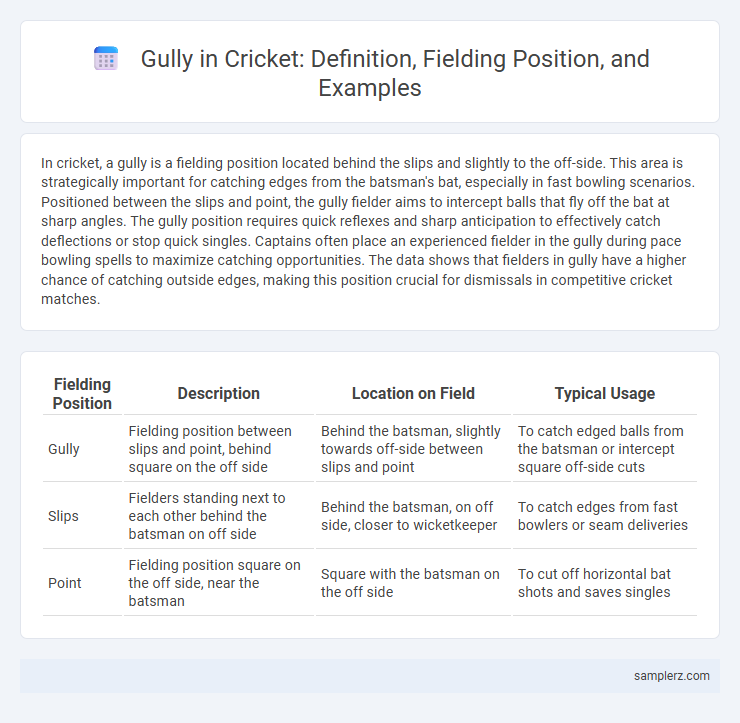In cricket, a gully is a fielding position located behind the slips and slightly to the off-side. This area is strategically important for catching edges from the batsman's bat, especially in fast bowling scenarios. Positioned between the slips and point, the gully fielder aims to intercept balls that fly off the bat at sharp angles. The gully position requires quick reflexes and sharp anticipation to effectively catch deflections or stop quick singles. Captains often place an experienced fielder in the gully during pace bowling spells to maximize catching opportunities. The data shows that fielders in gully have a higher chance of catching outside edges, making this position crucial for dismissals in competitive cricket matches.
Table of Comparison
| Fielding Position | Description | Location on Field | Typical Usage |
|---|---|---|---|
| Gully | Fielding position between slips and point, behind square on the off side | Behind the batsman, slightly towards off-side between slips and point | To catch edged balls from the batsman or intercept square off-side cuts |
| Slips | Fielders standing next to each other behind the batsman on off side | Behind the batsman, on off side, closer to wicketkeeper | To catch edges from fast bowlers or seam deliveries |
| Point | Fielding position square on the off side, near the batsman | Square with the batsman on the off side | To cut off horizontal bat shots and saves singles |
Understanding the Gully Position in Cricket
The gully position in cricket is located between the slips and point, typically on the off side, to intercept edging shots from the batsman. This fielding spot is crucial for catching fast, angled edges off the bat, especially against pace bowlers who induce outside edges. Mastering the gully role enhances a team's ability to take critical catches and apply pressure on the batsman during the game.
Role of the Gully Fielder: Key Responsibilities
The gully fielder in cricket plays a crucial role in intercepting edge shots between the slips and point, preventing runs and creating catching opportunities. Positioned strategically, the gully must maintain sharp reflexes and quick anticipation to capitalize on edges from fast bowlers and spinners alike. Effective gully fielding significantly enhances the team's chances of dismissing batsmen through catches and run-outs.
Famous Gully Fielders in Cricket History
The gully fielding position in cricket offers crucial support between slips and point, often responsible for sharp catches and quick ground fielding. Legendary gully fielders like Rahul Dravid and Mark Waugh are celebrated for their exceptional reflexes and safe hands, transforming gully into a key catching zone. Their agility and anticipation at gully significantly contributed to pivotal wickets and match-turning moments in cricket history.
When to Place a Fielder at Gully
Placing a fielder at gully is crucial when a right-handed batsman faces fast or medium-pace bowlers attempting to induce edges behind the wicket. This position is effective during outside off-stump deliveries, particularly in catching slips or pushing the batsman to play square of the wicket. Teams often deploy a gully fielder in conditions favoring swing or seam movement to exploit early breakthroughs.
Notable Catches Taken at Gully
Notable catches taken at gully in cricket display exceptional reflexes and sharp anticipation, often turning the tide of crucial matches. Legendary fielders like Rahul Dravid and Jonty Rhodes have made stunning catches in the gully region, showcasing agility and precision close to the bat. These game-changing moments highlight the importance of gully as a strategic fielding position in both Test and limited-overs formats.
How the Gully Impacts Bowling Strategy
Gully in cricket is a strategic fielding position located between the slips and point, significantly influencing bowling tactics by targeting edges and inducing catches. Bowlers exploit the gully to create pressure on batsmen, encouraging them to play drives that can result in edges to the gully fielder. This positioning encourages a more aggressive line outside off-stump, optimizing wicket-taking opportunities through sharp catches in the gully region.
Difference Between Gully and Slip Fielders
Gully in cricket is a fielding position located between the slips and point, designed to catch edges that fly off the bat at an angle. The primary difference between gully and slip fielders lies in positioning: slips stand closer to the wicketkeeper in a curved line behind the batsman, while gully fields wider and more square to the batsman. Gully is crucial for fast bowlers to trap players attempting square cuts or edges that don't carry directly to slips.
Techniques for Effective Fielding at Gully
Fielding at gully requires sharp reflexes, quick footwork, and consistent hand-eye coordination to intercept edges from fast bowlers. Players often adopt a low, balanced stance with slightly bent knees and hands positioned close to the ground to react swiftly to catches or stoppages. Practicing anticipation and catching drills like reaction ball exercises significantly enhances effectiveness in this crucial fielding position.
Memorable Moments Featuring the Gully Position
The gully position in cricket has been pivotal in iconic moments such as the 1983 World Cup final when Richard Hadlee's sharp reflexes at gully led to a crucial run-out, shifting momentum toward New Zealand. In Test cricket, Rahul Dravid's masterful slip and gully fielding saved numerous runs, notably during the 2001 Kolkata Test against Australia. The gully region remains a strategic spot where fast bowlers induce edges, creating unforgettable catches and turning points in matches.
Tips for Aspiring Gully Fielders
Mastering quick reflexes and maintaining a low, balanced stance are essential tips for aspiring gully fielders in cricket. Consistent practice in catching sharp edges and improving anticipation skills can significantly enhance fielding performance in the gully position. Effective communication with teammates and reading the batsman's footwork also contribute to successful fielding in this crucial cricketing spot.

example of gully in cricket Infographic
 samplerz.com
samplerz.com